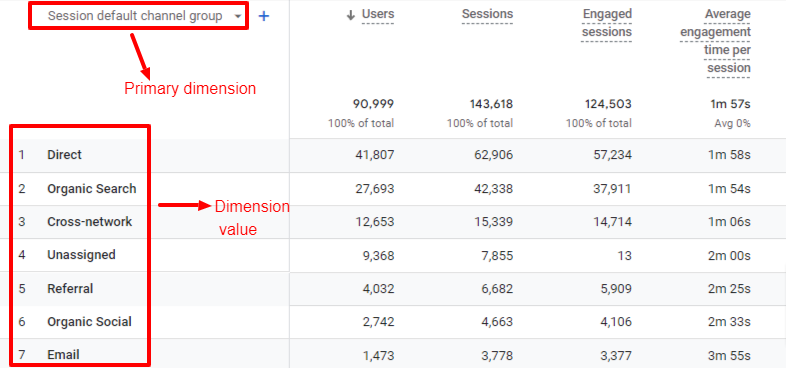Secondary Dimension in Google Analytics: Ideal Practices and Tips
Secondary Dimension in Google Analytics: Ideal Practices and Tips
Blog Article
Transform Your Analytics Strategy With Secondary Dimension in Google Analytics
By incorporating secondary measurements right into information analysis, a brand-new layer of insights arises, dropping light on elaborate customer behaviors and communications. The calculated application of secondary measurements holds the key to opening a treasure trove of indispensable information that can reinvent exactly how companies analyze and act upon their data.
Comprehending Secondary Dimensions in Google Analytics
Second dimensions in Google Analytics offer additional context to main information by enabling users to evaluate metrics across a 2nd measurement, providing much deeper understandings into individual actions and communications on a site. Secondary Dimension in Google Analytics. While main measurements provide essential information points such as pageviews, bounce rate, and session period, second dimensions supply a more detailed sight by segmenting the primary information additionally. This division enables customers to assess metrics in combination with an additional measurement, such as web traffic resources, demographics, or individual actions
Advantages of Utilizing Additional Dimensions
Using additional dimensions in Google Analytics uses a tactical advantage by enhancing the deepness of analysis and giving a much more extensive understanding of user communications and actions on a site. By including secondary dimensions, analysts can gain important insights right into the performance of certain segments or variables within their data. This makes it possible for a more comprehensive exam of user habits beyond surface-level metrics, permitting a much deeper expedition of the aspects affecting user engagement and conversions.

Exactly How to Execute Secondary Dimensions
When integrating second measurements in Google Analytics, one important action is to pick the relevant metrics and dimensions to enrich the analysis process. Clicking on this switch will certainly open up a drop-down menu listing different measurements that can be included to your primary dimension for much deeper understandings.
After picking the appropriate second measurement, such as 'Source/Medium' or 'Device Group,' Google Analytics will present the data in a much more comprehensive layout, allowing you to cross-analyze various facets of customer habits. Keep in mind to trying out different mixes of second and primary measurements to discover important patterns and patterns that can inform your advertising and marketing methods. By executing secondary measurements thoughtfully, you can get an extra extensive understanding of your site or app efficiency and make data-driven decisions to enhance your digital presence.
Studying Data With Second Dimensions
Boost your information evaluation in Read Full Article Google Analytics by including secondary measurements to dig much deeper into customer habits patterns and optimize your electronic marketing approaches effectively - Secondary Dimension in Google Analytics. By adding second dimensions to your key data, you can get important understandings that can assist you make educated decisions about your website or application performance
Examining data with additional measurements allows you to section your key data additionally, providing an extra comprehensive view of customer interactions. Integrating the primary dimension of 'source/medium' with a second dimension like 'touchdown web page' can expose which particular web pages are driving web traffic from various resources. This information can be important in improving your content method or maximizing your marketing campaign to enhance conversions.
In addition, utilizing additional measurements enables you to determine relationships in between different metrics, aiding you understand the effect of various elements on individual actions. Whether it's analyzing demographics along with customer engagement metrics or device classifications with conversion rates, second dimensions equip you to discover concealed fads and patterns that can assist your marketing efforts.
Optimizing Performance With Secondary Dimensions
To enhance the efficiency of information evaluation and decision-making in Google Analytics, including secondary measurements is key to optimizing performance metrics and gaining deeper understandings into user actions patterns. By utilizing additional dimensions, experts can dive past surface-level information and uncover important relationships that may otherwise go unnoticed. This optimization technique makes it possible for services to customize their advertising and marketing efforts better, recognize areas for enhancement in web site use, and improve total customer experience.
Secondary measurements use a more detailed sight of customer communications by giving added context to key information metrics. Coupling the main dimension of 'landing web page' with a second measurement like 'tool group' can disclose whether specific tools are much more most likely to drive involvement on particular touchdown web click here to find out more pages. This insight can notify receptive layout enhancements or targeted advertising and marketing techniques to improve efficiency.

Conclusion
Finally, the assimilation of additional dimensions in Google Analytics gives organizations with a powerful tool to boost their analytics technique. Secondary Dimension in Google Analytics. By delving deeper right into individual behavior and communications, marketing professionals can discover valuable understandings that can drive performance optimization and boost the general individual experience. Leveraging additional read review dimensions permits an extra detailed analysis of data, leading to more enlightened decision-making and customized marketing initiatives
Additional measurements in Google Analytics provide extra context to primary data by allowing individuals to assess metrics across a second measurement, supplying much deeper insights into individual habits and communications on a website. While primary dimensions offer essential information factors such as pageviews, bounce rate, and session duration, secondary measurements supply a more comprehensive sight by segmenting the key information even more.One of the crucial advantages of making use of secondary dimensions is the ability to discover connections and patterns that may not be immediately obvious when evaluating information with key measurements alone.When including secondary measurements in Google Analytics, one essential step is to pick the pertinent metrics and dimensions to enhance the analysis procedure. Matching the main measurement of 'landing page' with an additional dimension like 'device classification' can expose whether particular tools are much more most likely to drive involvement on particular touchdown web pages.
Report this page